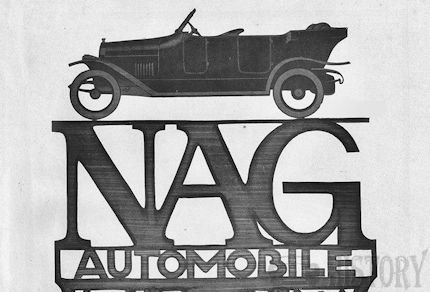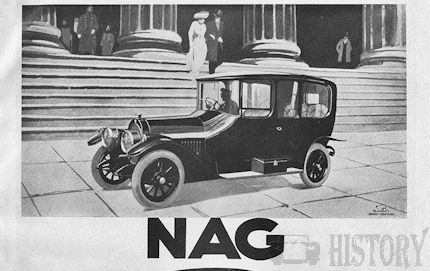Neue Automobil Gesellschaft (NAG)

Neue Automobil-Gesellschaft (NAG) was a German automobile manufacturer in Berlin. In 1915 it was renamed Nationale Automobil-Gesellschaft (NAG).
In 1902, German electrical company AEG purchased the coachbuilding side of Kühlstein under engineer Joseph Vollmer, renaming it NAG. The company's first two cars were reliable, if unoriginal: the two-cylinder Typ A and 5.2 liter (317ci) four-cylinder Typ B, both with chain drive, which resembled contemporary Mercédès.Shortly, an enlarged Typ B2, with 40/45hp(30kW) 7.9-liter (482ci) four, appeared. In 1907, one of these was given to the Empress Auguste Viktoria.
The next year, AEG got out of the car business, but NAG continued alone, introducing a 15 hp (11 kW) 1502 cc (91.7ci) four called Puck, with a remarkable (for the period) ability to rev to 3000 rpm, which may have contributed to its ability to win the Gothenburg Cup at the Swedish Winter Trials in 1912, 1913, and 1914. This sporting reputation was balanced by "aggressively ugly Prince Henry-type bodies".
The Puck would later be developed into a model known in Germany as the Darling.From 1911 to 1914, NAG's standard offering was an 8495 cc (518ci) 60 hp (44.7 kW), joined in 1912-14 by a 1502 cc (91.7ci) 10/12 hp (7.5 kW) K2, 2085 cc (127ci) 14/20 hp (10 kW) K4, 3308 cc (202ci) 20/25 hp (15 kW) K5, and a 5193 cc (317ci) 25/35 hp (19 kW).
During the recovery after World War I, NAG produced smaller numbers of 2.5-liter (153ci) C4s, essentially prewar K4s with new vee radiators replacing the prewar oval ones.
The economic situation was so serious, NAG partnered with Brennabor, Lloyd, and Hansa to form GDA (what in the U.S would be called a trust), to prevent competition from destroying them all. It proved successful for NAG, which prospered, enough to build the C4b sports variant, designed by chief engineer Christian Riecken (a Minerva racing driver prewar).
Riecken ran a C4b at the newly opened AVUS in 1922, winning at 84.3 mph (135.7 km/h), which was greater than the C4's top speed. It sacrificed nothing to reliability, as NAG went on to place well at the 1923 All-Russian Trials and the ADAC Reich Trials for 1923-26. In 1924, NAG hit its apex at Monza, where Riecken and Hans Berthold won the Gran Premio della Norte in a C4b, covering 1656 mi (2665 km) in 24 hours, an average of 68.99 mph (111.02 km/h), for which the model was renamed Monza.
In 1926, Protos (which had built the winner of the New York-Paris race) was acquired from Siemens-Schuckert, leading to "a series of dull six-cyliner cars". The next year, NAG again expanded, taking over Presto, which had just bought Dux, continuing to build the 2.6-liter Typ F and 3-liter Typ G. The difficulty was, despite their quality, none of these were distinctly different from other German cars of the period.
In response, NAG created a disastrous straight-eight (abandoned due to crankshaftwhip), which was never built, then hired former Impéria and Steiger man Paul Henze, "one of Germany's most gifted car designers", in an effort to remedy this situation with a new top-line car. Henze settled on a 4540 cc (277ci) V8, Germany's first to enter production which became "one of the outstanding German luxury cars of 1931, the NAG 212."
Rather than rely on conventional shaft drive, however, NAG chose to attempt to fit a Voran FWD system (designed by Richard Bussien) to a backbone chassis with independent suspension, which proved too ambitious, and the development costs disastrous.
In 1934, NAG ceased car production, while NAG-Büssing commercial vehicles continued to be produced for a few more years.
During the Second World War, the company produced the Sd Kfz 231, Sd Kfz 232, Sd Kfz 233, and Sd Kfz 234 series armoured cars.
Commercial vehicle production
The automobile factory NAG manufactured starting from 1903 the first trucks and coaches . The plans for the trucks had been developed by Joseph Vollmer . Almost all parts, as well as the wheels or tires, were manufactured on modern machines themselves. The first trucks were also built in large halls. They were equipped with two- and four-cylinder engines with up to 18 hp and had four types from 2 t to 6 t payload . Also in 1903, the NAG built a heavy front steering wheel tanker lorry tractor with two trailers , and thus the first truck in the world, designed by Josef Vollmer.
From 1906 double-decker buses with 26-32 hp, which reinforced u. a. for the Berliner Verkehrsbetriebe ( ABOAG ) were built and a few years later in the export, for example, went to Vienna in the then Austria-Hungary . In 1907, trucks up to 45 hp were built in three types with 3 and 4 and 6 t payload, which could reach up to 16 km / h. They had a leather cone clutch, four-speed gearbox, shaft drive and a mountain support. In addition to the truck engines, boat engines were also produced in large numbers. Electric vehicles were built according to patents of the company Stoll. The electric truck construction remained in the period 1911-1913, however, only one episode.
More and more important military products such as trucks and tractors were manufactured, and in 1912 the 3.5- and 5-ton trucks were mass-produced for the army command. The truck type ( B 07 17 ) with 3.5 t payload as control riderhad 32 HP and the 5-ton truck type ( S 8 5 ) as well as the omnibus type (FO 8) was equipped with a 45-HP engine , The omnibus type was also available as a fire engine . Furthermore, other armor material and aircraft engines were manufactured.
After the end of the First World War and the expiry of the war products from 1921 newly developed truck models were used. In both types built at the time, the engine and transmission were still installed separately and could already be ordered with pneumatic tires. The 3-tonner received a 40-horsepower engine, and the 5-tonner received a seven-speed gearbox . The vehicles were equipped with lumber, bottled beer, furniture and tipper - as well as omnibus structures. Typical was the large oval NAG grille .
Only in 1922 followed for the truck, a six-cylinder engine with 63 hp, which was also installed in the 32-passenger omnibus type. In 1925, four- and six-cylinder engines were manufactured as unitary engines. Completely new to NAG was a tractor with a setback front axle and a trailer for a payload of 10 tons, which was also called a large-area car . The semi-trailer body of Orenstein & Koppel (O & K) as a bus could carry 60 people. For the first time, the transmission received a Knorr compressed air circuit. The system of the fifth wheel mechanism, however, violated the patent of Thilo Kipping from Pirna , who theConstructed oeconomic trucks as semitrailers and triggered a complex lawsuit. In the new double-decker bus could be transported up to 100 people, he had an electrical transmission auxiliary circuit. At that time, six-wheeled buses and trucks with a payload of 10 tons were also built. 1927 got the six-cylinder engine 105 hp, 1928 then 120 hp, the performance could later be increased to 160 hp.
With the takeover of the Dux - Presto works in 1928, light truck types were also built as express trucks with 1.5 to 2.5 t (large delivery vans ) and could also be ordered as three - axle vehicles with trailing axle. This violated the Community of German Automobile Manufacturers GDA regulations, this also broke the commercial vehicle sales community soon on. In order to sell the truck with a diesel engine , " Deutz engines" were mainly installed in the fast lorries.
Despite large quantities, the commercial vehicle industry was no longer profitable, which is why in 1930 a merger with Büssing to the joint venture Büssing-NAG Vereinigte Nutzkraftwagenwerke AG took place. In 1932, the large trucks and buses of NAG were still equipped with Maybach V12 engines. Production of the semi-trailer type, also known as universal tractors, now had to be discontinued because NAG had lost the Kipping process. The engine department for the development of 4-, 6- and 12-cylinder NAG engines was closed in 1934.

Technical
-
NAG Model car models from 1904 to 1934
Type
Construction period
cylinder
capacity
power
Maximum speed (Vmax)
Type B (20/24 hp)
1904/1905
4 row
5193 cm³
24 hp (17.6 kW)
65 km / h
Type B2 (29/55 hp)
1905-1908
4 row
7963 cc
55 hp (40 kW)
90 km / h
Type AC4 (10/18 hp)
1907-1909
4 row
2799 cc
18 hp (13.2 kW)
55 km / h
Type N2 puck (6/12 hp)
1908-1911
4 row
1502 cm³
12 hp (8.8 kW)
55 km / h
Type K2 Darling (6/18 hp)
1911-1914
4 row
1466 cc
18 hp (13.2 kW)
65 km / h
Type K3 (8/22 hp)
1912-1914
4 row
2085 cm³
22 hp (16.2 kW)
70 km / h
Type K5 (13/55 hp)
1912-1914
4 row
3308 cm³
55 hp (40 kW)
90 km / h
Type K8 (33/75 hp)
1912-1914
4 row
8495 cc
75 hp (55 kW)
110 km / h
Type K4 (10/30 hp)
1914-1919
4 row
2597 cc
30 hp (22 kW)
75 km / h
Type C4 (10/30 hp)
1920-1924
4 row
2553 cc
30 hp (22 kW)
75 km / h
Type C4b (10/40 hp / 10/45 hp)
1922-1924
4 row
2553 cc
40-45 hp (29-33 kW)
100 km / h
Type D4 (10/45 hp)
1924-1927
4 row
2598 cc
45 hp (33 kW)
90 km / h
Type C4m (10/50 hp)
1925/1926
4 row
2614 cc
50 hp (37 kW)
120 km / h
Type D6 (12/60 hp)
1926-1928
6 row
3075 cc
60 hp (44 kW)
90 km / h
Type D7 (14/70 hp)
1927/1928
6 row
3594 cc
70 hp (51 kW)
90 km / h
Type 201 (12/60 hp)
1928-1930
6 row
3075 cc
60 hp (44 kW)
95 km / h
Type 204 (14/70 hp)
1928-1930
6 row
3594 cc
70 hp (51 kW)
95 km / h
Type 207 (16/80 hp)
1930-1933
6 row
3963 cc
80 hp (59 kW)
100 km / h
Type 208 (16/80 hp)
1930-1933
6 row
3963 cc
80 hp (59 kW)
110 km / h
V8 Type 218 (18/100 hp)
1931-1934
8 v
4508 cm³
100 hp (74 kW)
110 km / h
V8 Type 219 (18/100 hp)
1931-1934
8 v
4508 cm³
100 hp (74 kW)
120 km / h
Front type 220 (6/30 hp)
1933/1934
4 boxers
1484 cc
30 hp (22 kW)
75-85 km / h
